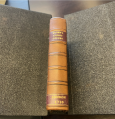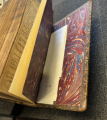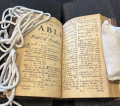Queen's Closet Opened: Difference between revisions
No edit summary |
|||
| Line 19: | Line 19: | ||
===Provenance=== | ===Provenance=== | ||
Esther B. Aresty | Esther B. Aresty a cookbook collector and culinary historian and her husband, Julian Aresty, donated her collection of rare cookbooks and cookery manuscripts to the University of Pennsylvania in 1996 shortly before they passed. Ester Aresty wrote on cooking, cookbooks, cuisine, and etiquette. Her collection spans of five centuries including 577 printed titles, thirteen manuscript cookbooks, and a collection of her papers. | ||
== Physical Analysis == | == Physical Analysis == | ||
Revision as of 03:32, 4 May 2024

The Queen's Closet Opened is an anonymously written book originating from the kitchen of Henrietta Maria , the wife of King Charles I. It includes customs and recipes of the old aristocracy. Originally, it was published in 1655 England after the execution of King Charles I and there are multiple editions. The recipe book was republished in 1656, 1658, 1659, 1661, 1662, 1663, 1668, 1671, 1674, 1679, 1683, 1684, 1696, 1698, 1710, 1713 and 1726 with edits and additions. The edition in the images is the 11th edition, published in 1710. It contains three parts: Part I: “The Pearl of Practice” (127 pages) , Part II: “A QUEEN’s Delight” (240 pages), Part III: “ The Compleat Cook:” (138 pages).
Background
Historical Context
The English Civil Wars, which lasted from 1642 to 1651, took place in the British Isles between supporters of King Charles I, known as Royalists or Cavaliers , and opposing groups, known as Parliamentarians or Roundheads . The war is believed to have begun because of tension between the king and Parliament. King Charles I raised an army in opposition to the desires of Parliament. Discontent also arose concerning the king's exercise of authority, his economic strategies, and differences in religious beliefs. [1] After many battles the Parliamentarians emerged victorious and King Charles I was executed in January 1649 for treason and crimes against England. The execution provoked the Scottish support for King Charles I’s son, Charles II , who was crowned king of Scotland. After the execution Oliver Cromwell served as Lord Protector until his death in September 1658. Cromwell was the incumbent of England when the book was first published in 1655 and the life of the aristocracy was fascinating to many. [2] The book is thought to have been published in response to the scandalous exposure of The King's Cabinet Opened, which was published in 1645. [3] In these times aristocratic families were frequently featured in literature, art, and theater. Their lavish lifestyles were a subject of admiration and curiosity among the common people. Amidst the chaos the aristocrats were subjects of fascination.
Content
Author & Publisher
The author and editor of the book is thought to have been Walter Montagu the Queen’s long-time friend and courtier. [4] He is best known for his play The shepheards paradise . It was performed by Queen Henrietta Maria and a cast of courtier women in 1633. [5]
Provenance
Esther B. Aresty a cookbook collector and culinary historian and her husband, Julian Aresty, donated her collection of rare cookbooks and cookery manuscripts to the University of Pennsylvania in 1996 shortly before they passed. Ester Aresty wrote on cooking, cookbooks, cuisine, and etiquette. Her collection spans of five centuries including 577 printed titles, thirteen manuscript cookbooks, and a collection of her papers.
Physical Analysis
Substrate / Binding
The cover is made of thick cardboard wrapped with a thin leather layer. The book was definitely rebound, as the binding looks new and is made of leather. There are border designs on the cover imprinted into the leather and around the edges of the front and back covers. Possible burn stamps or black paint designs are on edges of the cover around flap and on all other edges. When carefully observed inside the front cover and back cover and all edges of the book you can see the black imprinted designs.
-
Binding
-
Bottom view
-
Side view
-
Inside front cover
-
Inside back cover
Paratexts
There are a few sentences under the title of each of the three sections indicating what the book is about. There are different typefaces used in the title page, each of the lines have a different typeface or alternating typefaces. The size and typeface of the cover titles are different from the main text throughout the book.
-
The first page
-
Cover page of Part III: “The Compleat Cook:”
-
Pg 12-13 of “The Pearl of Practice”
The book has a title page for each of the three parts and labeled page numbers. Each new section starts with new page numbers and all parts have a table of contents in the back to help the reader navigate specifics. Each new recipe has a heading/title that is included in the table of contents. The table of contents is also in alphabetical order. At the end of all of the recipes in each section FINIS. is written and at the end of the table of contents The END. is written.
-
The Table of the Pearl of Practice
-
The Table of the Queen’s Delight
-
The Table of the Compleat Cook
Historical Significance
References
- ↑ J. Ohlmeyer, “English Civil Wars”, (Britannica ( Apr. 2024)), https://www.britannica.com/event/English-Civil-Wars
- ↑ Anon, “1713 The Queens Closet Opened, In Three Parts Part I Containing above five Hundred Choice Physical and Chirurgical Receipts”, (Rookebooks), https://www.rookebooks.com/1713-the-queen-s-closet-opened-in-three-parts
- ↑ L. Knoppers, “Opening the Queen’s Closet: Henrietta Maria, Elizabeth Cromwell, and the Politics of Cookery”, (Renaissance Quarterly, Vol. 60, No. 2 (Summer 2007), pp. 464-499.)
- ↑ K. Britland, “RECENT STUDIES OF THE LIFE AND CULTURAL INFLUENCE OF QUEEN HENRIETTA MARIA” (English Literary Renaissance, Vol. 45, No. 2 (Spring 2015), pp. 303-321)
- ↑ S. Poynting, “ Montagu, Walter” (Wiley Online Library (22 September 2017))










